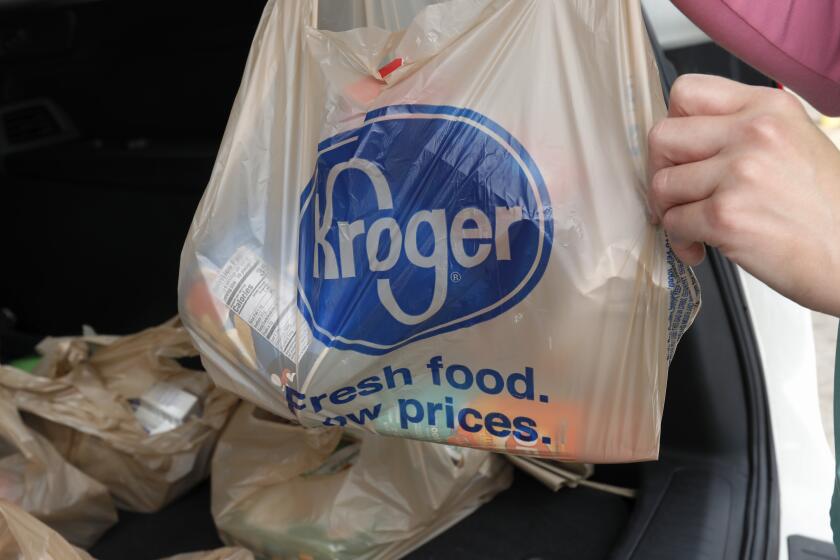The Renaissance of American Savings & Loan : Thrifts: Its 1989 profit is the envy of the industry. But it took the resources of Robert M. Bass, the leadership of Mario J. Antoci and $1.7 billion from taxpayers to get there.
It owned a foreclosed bordello, a mine that produced a Kitty Litter-like gravel for cats and a collection of securities and loans that at one point were worth a staggering $3 billion less than their original value.
In short, American Savings, once the nation’s largest savings and loan, up until the end of 1988 was the thrift industry’s equivalent of a huge toxic waste dump. It was a mess in need of a mind-boggling clean-up job, with nasty surprises lurking everywhere.
What a difference a year and a $1.7-billion bailout make. A little more than one year after the Stockton-based savings and loan was sold by regulators to Texas billionaire Robert M. Bass, American is not only in the black, it’s returning the kind of profit that most savings and loan executives dream about.
American last week disclosed that it earned $214.2 million in 1989. No other thrift in California, and probably no other nationwide, is likely to report as large a net income figure for 1989, although comparisons are misleading because American doesn’t pay taxes. Instead, its agreement with federal regulators calls for a chunk of the profit--$64 million last year--to be sent to a holding company. Most of the funds collected there over 10 years are eventually paid to a government agency.
American’s turnaround is partly a tribute to the hard work and drastic cost cutting of Chief Executive Mario J. Antoci, a well-respected manager who previously worked for one of American’s chief rivals. Free of having to deal constantly with regulators, and blessed with Bass’ deep financial resources, Antoci moved swiftly to eliminate unneeded branches and operations while restoring American’s public image. Antoci and American also benefited from good timing, as falling interest rates last year boosted earnings on its loans.
But American’s profit comeback can also be laid to government generosity. Regulators, under pressure to dispose of weak or failed thrifts, granted generous concessions in 1988 and early 1989 to investors who agreed to take the thrifts off the government’s hands. Some of these investors, including Bass, are among the nation’s wealthiest individuals.
Now some members of Congress, particularly House Banking Committee Chairman Henry B. Gonzales (D-Tex.), want to review those deals to see if the regulators were overly generous. The Resolution Trust Corp., the government agency created to sell assets of troubled thrifts, is even reviewing bid proposals from experts it will hire to analyze the thrift deals.
So far, the Bass-American deal has attracted far less criticism than one by New York investor Ronald O. Perelman, who acquired a collection of failed Texas savings and loans. Some estimates have Perelman making 170% on his $160-million investment.
Edwin J. Gray, former chairman of the Federal Home Loan Bank Board, now the Office of Thrift Supervision, argues that Bass got a great deal because regulators were negotiating from a position of weakness after talks with Ford Motor Co.’s First Nationwide unit broke down.
“The Bass group has some of the best negotiators in the world. I think they kind of took the bank board to the cleaners because they got such a good deal,” said Gray, who left his post the year before the agreement was reached and now is head of a Miami thrift.
Two former bank board members who were key in negotiating the deal, Roger Martin and Lawrence J. White, bristle at suggestions that the agency failed to negotiate a good enough agreement. They note that there were no better offers, there was no money at the time to pay off depositors, the cost of pulling the plug on American would have been much higher than selling it to Bass, and the government benefits if American does well because it retains a 30% ownership stake.
“As the years go by, history will be very good to us,” said Martin, now a Wisconsin investment banker.
Federal officials dismiss fears among some thrift investors that they will renegotiate contracts extensively and make wholesale changes to the deals. Still, Bass and others have already found that what the government grants, it can take away.
Last month, regulators, citing provisions in last year’s thrift bailout bill, wiped out some $300 million of American’s capital, the financial cushion that thrifts maintain to protect against losses. That capital came in the form of various accounting sweeteners that it had been given in the deal. Eliminating them will make it more difficult for American to pursue expansion plans.
Although Bass didn’t make out as well as Perelman apparently did, Bass clearly cut a good deal. The cost to taxpayers of the bailout was $1.7 billion, and the government took American’s problem assets and put them into a so-called bad bank whose assets are being sold over time. In contrast, Bass spent $400 million of his own money on the deal--$350 million into the thrift and $50 million in acquisition costs. In return he got a 70% stake in American, with the government owning the other 30% for now.
Bass’ return the first year with his 70% stake: about 37.5%. It would have been even higher had American not made the mistake of buying nearly $500 million in risky junk bonds just before that market tumbled. American executives counter that although the S&L; posted a hefty return, Bass could have made a good profit had he chosen to put his money in a number of other investments. Bass is not pocketing his profit, but instead is reinvesting it into the thrift.
Much of the return is the result of the frenetic work in the first year by Antoci, 55, a former accountant who spent 21 years with H. F. Ahmanson and its Home Savings of America thrift. Antoci, who was Ahmanson’s president and chief operating officer, was recruited by the Bass group as American’s chief executive. He in turn raided nearly every major thrift for talent and hired two consulting firms to comb through American’s operations looking for fat.
“Every single department had one of these guys in a blue suit take a look at it,” Antoci said.
He concedes that scrutiny hurt morale and caused hard feelings. But it also turned up a lot of potential savings, such as branches down the street from each other that could be combined or two separate loan servicing offices instead of one.
In one case, Antoci found that the company had hired a computer firm to perform data processing work that had been done in house. Trouble was, the in-house data processing department stayed put, even reworking at night the numbers provided by the outside contractor. Such inefficiencies were common.
“I didn’t know it was as bad as it was until I got there,” said Antoci, who runs American from the thrift’s administrative offices in Irvine.
Overall, payroll was cut by about 400 workers, to 4,783. Cuts were so deep that one job that was eliminated belonged to a son of William J. Popejoy, an American director and the man who headed the operation through its turmoil in the pre-Bass days. Expenses fell from $2.15 for every $100 in assets when Antoci took over at the end of 1988 to $1.78 by the end of last year. He hopes to cut that figure to $1.50 by the end of next year.
Repairing American’s tattered image was an equally difficult challenge.
American was once one of California’s most conservative thrifts under the leadership of financier S. Mark Taper, who probably is best known as the founding father of the Mark Taper Forum theater.
In 1983, American was merged into Financial Corp. of America, led by Charles W. Knapp. Knapp combined American with his Stockton-based State Savings & Loan and turned the thrift into one of the nation’s highest-flying savings and loans.
Fueled by high-rate deposits from Wall Street “money brokers,” Knapp financed speculative real estate ventures and securities purchases. In 1984, he was ousted by regulators after the Securities and Exchange Commission forced FCA to restate its earnings to show a huge loss, which triggered a $7-billion run on deposits.
Antoci moved quickly to change the name from American Savings & Loan to American Savings Bank, shunning the tarnished savings-and-loan label as many other thrifts have done.
American also exploited a less-than-scientific survey published in California Business magazine that identified American Savings as tops in “consumer banking” among S&Ls.; No matter that only 122 out of 1,000 readers returned the survey. The result was what Antoci needed, and he based an entire advertising campaign on it.
He also got rid of high-rate deposits from money brokers, lowered its rates for certificates of deposit to levels in line with other thrifts and originated $3 billion in loans, mostly home loans that adjust every month, which protects an S&L; against fluctuating interest rates. Antoci initially found that only 20% of American’s home loans were adjustable and many didn’t change for six months. Now 73% are adjustable, and they rise and fall monthly based on interest rates.
Antoci makes it a point not to blame Popejoy, who now works for Bass, noting that he had his hands full dealing with regulators and was short of money to make all of the necessary changes. Instead, he said, he found operations that former chief Charles Knapp had failed to consolidate in 1983 when he combined American Savings with State Savings.
“He merged them financially, but not functionally,” Antoci said.
Some competitors quietly complain that Bass and American got a sweet deal. But others say they admire how quickly Antoci has reshaped the thrift.
“American appears to be a tough, rational competitor. Mario’s reputation has always been outstanding,” said Herbert M. Sandler, chairman of Oakland-based Golden West Financial, parent of competitor World Savings.
How much will Bass make in the future? Experts say the first-year results may be an exception for several reasons. One is that American receives interest income from the “bad bank” split off from American as part of the Bass deal, and the rate at which they receive that income decreases over time. Also, housing sales have slowed, and thus so has mortgage lending.
Martin, the former Home Loan Bank Board member, said the rate of return on Bass’ investment may decrease to 20% to 25%, about what Martin said he originally expected but still a healthy return.
The other question is whether Bass wants to keep American. Some experts, including thrift consultant Bert Ely of Alexandria, Va., suggest that Bass may find it hard to resist cashing out in a few years.
“My impression is that American will be sold eventually. It looks like a venture capital deal,” Ely said.
A Bass spokesman, however, strongly denies such speculation, citing two reasons. First, executives recruited at American have been promised that Bass is a long-term investor. Second, the tax benefits that Bass enjoys from the purchase cannot be transferred to a new owner.
AMERICAN SAVINGS CUTS COSTS . . .
Money spent for general and administrative expenses for every $100 in assets 1988: $2.15 1989: $1.78 1990 (Projection): $1.67 1991 (Projection): $1.50
Source: American Savings
. . . AND GETS ITS LOANS INTO SHAPE
Percentage of residential loans with adjustable interest rates Dec. 28. 1988: 20% January, 1990: 73%
Source: American Savings
More to Read
Inside the business of entertainment
The Wide Shot brings you news, analysis and insights on everything from streaming wars to production — and what it all means for the future.
You may occasionally receive promotional content from the Los Angeles Times.








